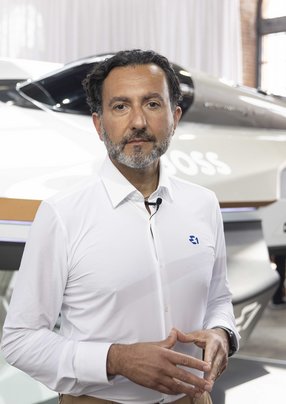The emerging trend of electric vehicles (EVs) was catalysed majorly by the actions of Formula E and the Extreme E off-road championship, but electrification goes beyond the road. In the most unlikely turn of events, there is now demand across the globe for electric boat solutions, which is where E1 Series and Seabird Technologies come into their own.
As the CEO of E1 Series and the CTO of Seabird Technologies, Rodi Basso’s stake in the industry is immense, which would explain his passion for the E1 Series project.
Taking technology and creating an electric motorsport
Nobody would’ve guessed years ago that power boating would turn electric. Putting electric motors on water sounded ludicrous purely due to the relationship between the two. Seabird Technologies was founded for this purpose, which follows a similar approach to the electric car market to produce EVs for luxury tenders or managed fleet services.
Developing electric propulsion for applications in boating required a different approach and the company decided to build its hydrofoils for the market. But, to raise awareness of electric boat innovation and the impending deadlines for climate change action, the E1 Series was born as a practical response to the cause. E1 acts as a global influencer of e-mobility adoption.
So where does Basso come into this?
He was heavily involved in Formula E development during his time at McLaren Applied when he led the business as the developer of the EV battery that the current generation 2 car still uses. Basso idealised the E1 Series boating championship and his position puts the motorsport in good stead as he is a critical member of the team, selecting the technologies used in the RaceBird and the partnerships that have been and will be formed by the project.
As a result, the RaceBird was tested for the first time in Spring of 2022 and is set to be the machine of choice for the championship in 2023.
What is the RaceBird?
Designed by Sophi Horne, Founder, Chairman and Head of Design at Seabird Technologies, the boat resembles the natural gliding of a bird over a body of water.
The RaceBird is the vehicle that will enable the E1 race series and with hydrofoil technology, the boat is not only less invasive in the water, but it reduces the amount of drag on the boat to allow for a smaller battery. This allows for cost reduction in the construction of the boat, but also a smaller impact.
The boat takes hydrofoil technology, which was already experimented with over the past century and puts it into practice to create a technologically advanced boat that could pioneer the technology for further marine vehicle manufacturers.
Basso also explained that the race format will showcase the charging capability of the RaceBird, by including a rapid charging period between the semi-final and final of each race.
Leaving behind a cleaner, healthier ocean
Sustainability has been embedded early-on into the E1 Series culture and is seen as less of a strategy and more of an organisational culture. The organisation, similar to Formula E, commits a lot of its energy to ensuring that each racing venue is left in a better state than when the teams arrive. The motorsport will also draft in the expertise of the distinguished marine biologist, Carlos Duarte, who has spent most of his life in science and is ready to join a movement in sustainability—to facilitate action.
Through the E1 Series, not only will the championship provide the necessary visibility to action the switch to e-mobility, but also align countries with the needs of the planet, through media representation and sustainable development.
“I believe that the sponsorship industry should still consider the visibility of the brands around us, but associate those brands with correct action—with execution,” says Basso.
“Not only are we building a marketing platform, but we want to build an execution platform. So when you partner with us, you’re a part of something that is releasing a long-standing impact after we leave the location of the race.”
The Blue Action Programme (BAP) is one of the ways in which E1 finds local organisations to sponsor the race and provide a meaningful impact in the area. Duarte is an important person in this as he verifies the projects through initial research and analysis of the venue and comes up with a plan to increase biodiversity and the health of ecosystems below the water’s surface.
“And then we look at sponsors that want to be a part of this journey. Most will only be used to hire local labour that will be trained, educated and paid to implement the work,” says Basso. He also highlights the two main areas of sustainability are environmental and social action.
Highlighting the best of local sustainability
The E1 series will not only create a platform to share the triumphs of e-mobility, more sustainability projects and businesses built on environmental, social and governance (ESG) will be showcased by the series. According to Basso, this will present to the world the opportunities that lie in electrification and sustainability technology innovation.
“When people say there will be loss of jobs because of the electrification industrial revolution, I just laugh at them. There will be a loss of existing jobs, but there will be a plethora of new jobs that may still have to be invented.”



